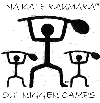
THE HANA HOU SERIES Wahine o Hawai`i © 1999 Kawika Sands |

THE HANA HOU SERIES Wahine o Hawai`i © 1999 Kawika Sands |
|
Kekauluohi, Emma
Times of Change: From 1826 until 1893, the United States recognized the independence of the Kingdom of Hawai`i, extended complete diplomatic recognition to the Hawaiian Government, and entered into treaties and conventions with the Hawaiian monarchs to govern commerce and navigation in 1826, 1842, 1849, 1875, and 1887. The sugar industry was doing very well, but with the falling number of Hawaiians, contract labor was necessary to maintain the industry. The Chinese were the first to be "imported." Then came the Portuguese, the Puerto Ricans, the Koreans, the Filipinos, and finally the Japanese. With the eventual intermarriage that followed, the numbers of pure Hawaiians continued to fall. Because many of these people had to live and work together, they needed a way to communicate with each other. They formed a kind of dialect that incorporated words and expressions from these different languages and the cultures they came from. It was a kind of broken/pidgin English otherwise known in Hawai`i today as "pidgin."
KEKAULUOHI (? - 1845) Under her premiership, she took a stand in matters of religious tolerance and allowed all faiths to practice in Hawai`i. With this freedom, the Catholic and Mormon faiths flourished bolstering the Hawaiian opportunity for educational opportunities, though for girls, teaching was mainly in the domestic area.
QUEEN EMMA (1836 - 1885) Upon the death of his uncle, Alexander was crowned Kamehameha IV. He and Emma were married in Kawaiahao Church on June 19, 1856. Although they were personable and of impeccable lineage, they were received cooly in the community because of their excessive British leanings. She and the King ran the court with great style and elegance. Both were well educated and versed in the arts and often participated in the musicals and operas they produced. Although the tone of the court was European, the King and Queen did not ignore their Hawaiian heritage. They were appalled at the number of Hawaiians who were dying because of the lack of proper medical care. Kahuna medicine could not combat the virulent germs brought by the outside world. Between the King and Queen they collected enough money from friends and family to finance a hospital known as the Queen's Hospital. Queen Emma was much loved and is still revered for her compassion. She built schools and hospitals and cared for smallpox patients in her home. Born Emma Rooke, she married Alexander Liholiho (Kamehameha IV) and inherited her home from her uncle, John Young II. Prominent people such as the Duke of Edinburgh came often for dinner, dancing, and croquet on the lawn. The house remained empty for five years after Queen Emma died in 1885. In 1913 the mansion was rescued from demolition by the Daughters of Hawai`i, a historical preservation society. One day, malicious gossip reached the king. It was rumored that Emma and the secretary, Henry Neilson, were having an affair. The rumors were later proved untrue but it was too late. The King, for all his brilliance and superior intellect, was a deeply moody man. He took to drinking heavily and one night shot Neilsen. Neilsen survived and never filed charges against the king. The king however brooded over his guilt and the couple consoled themselves with religion. They established an Episcopal church in 1862 but tragedy struck again. Their son, Prince Albert, was suddenly taken ill and later died at the age of four. The king never recovered from the shock and fifteen months later, he also died. At twenty-seven Queen Emma was a widow and childless. For two weeks she stayed in the vault near them despite the dampness and inadequate ventilation to be near her loved ones. Lot, Alexander's older brother, was crowned King Kamehameha V. It was said the he had loved Emma for years and after a decent interval he proposed marriage. Lot and Alexander were as different as night and day but Emma never remarried and Lot died without heir. William Lunalilo (the boy who hated to be parted from his mother), and David Kalakaua vied for control of the throne of Hawai`i. The people chose Lunalilo but he died one year later and once again the people had to choose. This time, David Kalakaua was chosen. HAWAIIAN HISTORICAL CHRONOLOGY
|

Last Modified: Saturday - 19991113.15:22 EST
Copyright © 1999 Kawika Sands
Produced online by HoloHolo Internet Publishing all rights reserved